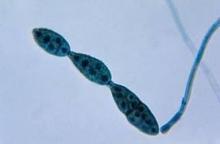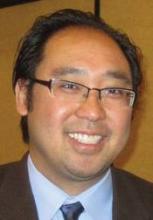User login
SAN FRANCISCO – Underlying pulmonary fungal colonization or infection may be the reason that some children with severe asthma don’t respond fully to conventional treatments.
Severe asthma with fungal sensitization (SAFS) has been recognized only recently. In adults, SAFS has been found to respond to oral itraconazole (Am. J. Respir. Crit. Care Med. 2009;179:11-8).
SAFS also occurs in children, according to Dr. Alfin G. Vicencio, chief of pediatric pulmonology and cystic fibrosis at Cohen Children’s Medical Center in New Hyde Park, N.Y., and his colleagues.
The researchers looked at 41 children, teens, and young adults (aged 2-21 years) with severe asthma who were failing level 4 or greater combination asthma therapy, and found that 17 (41.5%) had serum fungal IgE levels above 100 IU/mL and evidence of fungal sensitization on radioallergosorbent or skin-prick tests, indicating SAFS.
Eleven (65%) of those patients were sensitive to more than one fungal species. Aspergillus was the most commonly implicated species, followed by Alternaria, Candida, Cladosporium, Setomelanomma, Mucor, and Penicillium, Dr. Vicencio said at an international conference of the American Thoracic Society.
Boys and girls were affected equally, but SAFS patients tended to be older and have worse results on pulmonary function tests (PFTs) than their peers did, with forced expiratory volume in 1 second (FEV1) at 73.33% of predicted, for instance, compared with 91.60% in those without SAFS. Some of the children who didn’t meet the criteria for SAFS diagnosis had high IgE levels but no evidence of fungal sensitization, or evidence of fungal sensitivity but normal IgE levels.
"The contribution of fungi to poorly controlled asthma in children is likely to be underestimated, as is the number of patients who might benefit from antifungal therapy," Dr. Vicencio said.
So far, he’s treated about a dozen pediatric SAFS patients with itraconazole. "About half of them have done very well. Their asthma is better controlled. We have documented some PFT improvements. Their IgE levels are variable; some of them are dropping dramatically, and some are not," he said.
Overall, "what it looks like is that fungal sensitization is a risk factor for severe persistent disease. We do believe that there is going to be a role for antifungal agents in certain select populations," he said.
The ongoing series now includes about 60 children with severe, poorly controlled asthma. "Something on the order of 60% actually have fungal sensitization," Dr. Vicencio said.
Sputum testing or bronchoalveolar lavage is planned to see if young SAFS patients actually have fungus in their lungs.
Genotyping is also underway to see if these patients have a mutation in the CHIT1 gene, which encodes for chitotriosidase, a kind of natural antifungal found in mammals. Dr. Vicencio has published a case series in which the mutation was present in six pediatric SAFS patients tested for it. Of the three treated with itraconazole, two responded well and one responded "dramatically" (Pediatrics 2010;126:e982-5).
About a third of the general population has the mutation, and it doesn’t cause disease in most. However, in someone with asthma and fungal exposure, "we believe the mutation" might cause "a perfect storm for asthma," he said.
Dr. Vicencio said he has no relevant disclosures.
SAN FRANCISCO – Underlying pulmonary fungal colonization or infection may be the reason that some children with severe asthma don’t respond fully to conventional treatments.
Severe asthma with fungal sensitization (SAFS) has been recognized only recently. In adults, SAFS has been found to respond to oral itraconazole (Am. J. Respir. Crit. Care Med. 2009;179:11-8).
SAFS also occurs in children, according to Dr. Alfin G. Vicencio, chief of pediatric pulmonology and cystic fibrosis at Cohen Children’s Medical Center in New Hyde Park, N.Y., and his colleagues.
The researchers looked at 41 children, teens, and young adults (aged 2-21 years) with severe asthma who were failing level 4 or greater combination asthma therapy, and found that 17 (41.5%) had serum fungal IgE levels above 100 IU/mL and evidence of fungal sensitization on radioallergosorbent or skin-prick tests, indicating SAFS.
Eleven (65%) of those patients were sensitive to more than one fungal species. Aspergillus was the most commonly implicated species, followed by Alternaria, Candida, Cladosporium, Setomelanomma, Mucor, and Penicillium, Dr. Vicencio said at an international conference of the American Thoracic Society.
Boys and girls were affected equally, but SAFS patients tended to be older and have worse results on pulmonary function tests (PFTs) than their peers did, with forced expiratory volume in 1 second (FEV1) at 73.33% of predicted, for instance, compared with 91.60% in those without SAFS. Some of the children who didn’t meet the criteria for SAFS diagnosis had high IgE levels but no evidence of fungal sensitization, or evidence of fungal sensitivity but normal IgE levels.
"The contribution of fungi to poorly controlled asthma in children is likely to be underestimated, as is the number of patients who might benefit from antifungal therapy," Dr. Vicencio said.
So far, he’s treated about a dozen pediatric SAFS patients with itraconazole. "About half of them have done very well. Their asthma is better controlled. We have documented some PFT improvements. Their IgE levels are variable; some of them are dropping dramatically, and some are not," he said.
Overall, "what it looks like is that fungal sensitization is a risk factor for severe persistent disease. We do believe that there is going to be a role for antifungal agents in certain select populations," he said.
The ongoing series now includes about 60 children with severe, poorly controlled asthma. "Something on the order of 60% actually have fungal sensitization," Dr. Vicencio said.
Sputum testing or bronchoalveolar lavage is planned to see if young SAFS patients actually have fungus in their lungs.
Genotyping is also underway to see if these patients have a mutation in the CHIT1 gene, which encodes for chitotriosidase, a kind of natural antifungal found in mammals. Dr. Vicencio has published a case series in which the mutation was present in six pediatric SAFS patients tested for it. Of the three treated with itraconazole, two responded well and one responded "dramatically" (Pediatrics 2010;126:e982-5).
About a third of the general population has the mutation, and it doesn’t cause disease in most. However, in someone with asthma and fungal exposure, "we believe the mutation" might cause "a perfect storm for asthma," he said.
Dr. Vicencio said he has no relevant disclosures.
SAN FRANCISCO – Underlying pulmonary fungal colonization or infection may be the reason that some children with severe asthma don’t respond fully to conventional treatments.
Severe asthma with fungal sensitization (SAFS) has been recognized only recently. In adults, SAFS has been found to respond to oral itraconazole (Am. J. Respir. Crit. Care Med. 2009;179:11-8).
SAFS also occurs in children, according to Dr. Alfin G. Vicencio, chief of pediatric pulmonology and cystic fibrosis at Cohen Children’s Medical Center in New Hyde Park, N.Y., and his colleagues.
The researchers looked at 41 children, teens, and young adults (aged 2-21 years) with severe asthma who were failing level 4 or greater combination asthma therapy, and found that 17 (41.5%) had serum fungal IgE levels above 100 IU/mL and evidence of fungal sensitization on radioallergosorbent or skin-prick tests, indicating SAFS.
Eleven (65%) of those patients were sensitive to more than one fungal species. Aspergillus was the most commonly implicated species, followed by Alternaria, Candida, Cladosporium, Setomelanomma, Mucor, and Penicillium, Dr. Vicencio said at an international conference of the American Thoracic Society.
Boys and girls were affected equally, but SAFS patients tended to be older and have worse results on pulmonary function tests (PFTs) than their peers did, with forced expiratory volume in 1 second (FEV1) at 73.33% of predicted, for instance, compared with 91.60% in those without SAFS. Some of the children who didn’t meet the criteria for SAFS diagnosis had high IgE levels but no evidence of fungal sensitization, or evidence of fungal sensitivity but normal IgE levels.
"The contribution of fungi to poorly controlled asthma in children is likely to be underestimated, as is the number of patients who might benefit from antifungal therapy," Dr. Vicencio said.
So far, he’s treated about a dozen pediatric SAFS patients with itraconazole. "About half of them have done very well. Their asthma is better controlled. We have documented some PFT improvements. Their IgE levels are variable; some of them are dropping dramatically, and some are not," he said.
Overall, "what it looks like is that fungal sensitization is a risk factor for severe persistent disease. We do believe that there is going to be a role for antifungal agents in certain select populations," he said.
The ongoing series now includes about 60 children with severe, poorly controlled asthma. "Something on the order of 60% actually have fungal sensitization," Dr. Vicencio said.
Sputum testing or bronchoalveolar lavage is planned to see if young SAFS patients actually have fungus in their lungs.
Genotyping is also underway to see if these patients have a mutation in the CHIT1 gene, which encodes for chitotriosidase, a kind of natural antifungal found in mammals. Dr. Vicencio has published a case series in which the mutation was present in six pediatric SAFS patients tested for it. Of the three treated with itraconazole, two responded well and one responded "dramatically" (Pediatrics 2010;126:e982-5).
About a third of the general population has the mutation, and it doesn’t cause disease in most. However, in someone with asthma and fungal exposure, "we believe the mutation" might cause "a perfect storm for asthma," he said.
Dr. Vicencio said he has no relevant disclosures.
FROM AN INTERNATIONAL CONFERENCE OF THE AMERICAN THORACIC SOCIETY

